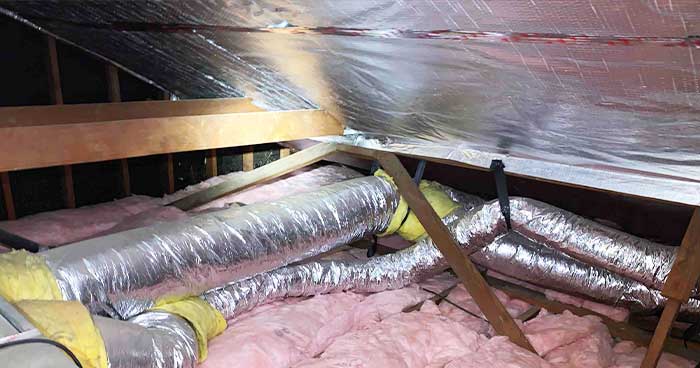
As we become more aware of the challenges facing the world, more homeowners are asking how they can be more energy efficient. A simple solution that can help a larger problem is radiant barrier, found in an attic. This additional insulation method can help stop UV rays from even getting into your attic. If you’re wondering what radiant barrier is, we’re here to answer your questions.
What is Radiant Heat?
A quick lesson in radiant heat is your car. When you park your car in direct sunlight—especially during a Sacramento summer—the interior will be much hotter than the outside temperature.
This happens because of radiant energy. Radiant energy takes shape in electromagnetic waves. These waves can transfer heat through UV energy, such as that generated by the sun.
During the summers, your attic takes a beating from radiant heat. When the temperature reaches a cool 95° outside. Your attic can easily heat up to 150°.
This extreme warmth can heat your insulation so much that it makes your home much warmer. In turn, your HVAC system is not only getting cooked in the attic, but also forced to work harder to heat your home.
This heat can also degrade your ductwork. And just think of all your grandma’s knick-knacks you have stored up there.
How does Radiant Barrier Work?
Let’s think about a car in the sun again. When you leave it in the sun for an extended period of time, radiant energy heats up the interior. But what if you used a reflective sunshade?
By putting a reflective sunshade over the windshield, you’re directing that radiant energy away from your car and back into the atmosphere. This is how radiant barrier works, but for your home.
You can also liken this to an insulated stainless steel cup. Your home can stay cool all day the way your drink stays cool for a longer period of time.
What is Radiant Barrier Made From?
Once again, we’re going back to the car theory. A sunshade is usually made of reflective material. This reflective material sends heat rays back where they came from.
 Think of radiant barrier as industrial grade tin foil for your home. Don’t get too literal though. The tin foil in your kitchen will not work for your home.
Think of radiant barrier as industrial grade tin foil for your home. Don’t get too literal though. The tin foil in your kitchen will not work for your home.
For radiant barrier installations, we recommend bringing a professional. The ones a Bell Brothers know exactly what to do.
What are the Benefits?
When installed properly and used in the right conditions, radiant barriers have a lot of perks. Radiant barriers are highly recommended for homes with HVAC systems and ductwork in the attic.
Think of how hot it gets in your car after a day in the sun, now transfer that heat to your attic. It’s so strong it can easily degrade your ductwork and force your HVAC system to work much harder than it needs to.
 Radiant barrier can elongate the life of your HVAC system and ductwork when they are in the attic. They also help keep any holiday decorations or guest bedding safe as well.
Radiant barrier can elongate the life of your HVAC system and ductwork when they are in the attic. They also help keep any holiday decorations or guest bedding safe as well.
Don’t forget saving on your bill. Radiant barrier can cut between 5% and 10% off your energy bill. This also helps you move one step closer to going green as well.
This form of attic insulation is an innovative, cost effective way to keep your home cool during the summer and save on your bills. If you want to learn more, contact Bell Brothers today.

